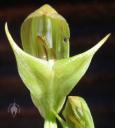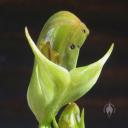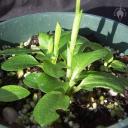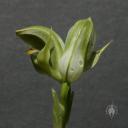Pterostylis
This unusual orchid is a Pterostylis. If you don’t enjoy trying to pronounce Greek scientific names, you’ll be happy to know that Pterostylis are nicknamed “greenhoods” in their native Australia and New Zealand. The bug-eaten pair of flowers in the first set of photos shows the unusual flower shape, including a slightly twisted flower lip in the center. The flower’s twisted lip is on a hinge, and snaps shut when touched by an insect. This traps the insect inside the flower, and the only escape route is past the orchid’s pollen.
Unlike the photos above, which show 2 separate flowers, the next photos show a rare double-headed flower. They also show the plants’ small leaves and flower spikes. Dormant in summer, new leaves emerge with winter rains, and the orchid blooms in spring. As the hot, dry summer begins, leaves die back to underground tubers, which are similar to bulbs and capable of surviving until the next rainy season.
Many greenhoods like to grow in sandy soil with light shade and regular water. Although they can handle a light freeze, they prefer mild winter temperatures typical of a Mediterranean climate. This particular species, Pterostylis curta, is common along Australia’s southeastern coast and Tasmania, where its tubers can multiply into large colonies of plants.
Explore posts in the same categories: Cool Growers, Dormancy, Growing, Mini Orchids, Photos
Subscribe to the About Orchids Blog:
![]()









April 27th, 2009 at 1:46 am
such a freaky flower! certainly doesn’t look like any oarchid i’ve seen before … great post!
Robert
August 14th, 2009 at 12:22 pm
[…] Some use the tried-and-true floral method of offering nectar. Others, like Lady Slippers and Pterostylis, temporarily trap an insect and force it to exit past their pollen. […]
August 25th, 2009 at 10:47 am
Weird! The double-headed flower looks like one of those double-headed snakes. They even have forked tongues.